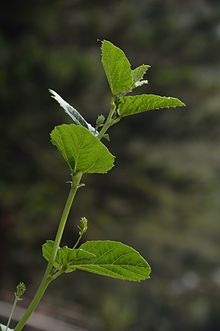Cullen corylifolium
| Cullen corylifolium | |
|---|---|

| |
| Scientific classification | |
| Kingdom: | |
| (unranked): | |
| (unranked): | |
| (unranked): | |
| Order: | |
| Family: | |
| Genus: | |
| Species: | P. corylifolia
|
| Binomial name | |
| Psoralea corylifolia | |
Psoralea corylifolia (Babchi) is an important plant in the Indian Ayurveda and Tamil Siddha systems of medicine, and also Chinese medicine. The seeds of this plant contain a variety of coumarins including psoralen. The seeds have a variety of traditional medicinal uses, but the specific role (if any) of psoralen in these uses is unknown.
Pharmacology
An extract of the plant's fruit Fructus psoraleæ has been shown to act as a norepinephrine-dopamine reuptake inhibitor in vitro.[1]
Extracts obtained from the seeds of P. corylifolia have been shown to inhibit mitochondrial complex I in vitro and may therefore increase susceptibility to oxidative stress.[2]
P. corylifolia has been implicated in at least one case of severe hepatotoxicity in a 64-year-old woman who self-medicated with a variety of Aryuvedic herbs for her vitiligo. The authors identify psoralens as "the primary candidate causing the hepatotoxic reaction".[3]
Chemical constituents
P. corylifolia extract contains a number of chemical compounds including flavonoids (neobavaisoflavone, isobavachalcone, bavachalcone, bavachinin, bavachin, corylin, corylifol, corylifolin and 6-prenylnaringenin), coumarins (psoralidin, psoralen, isopsoralen and angelicin) and meroterpenes (bakuchiol and 3-hydroxybakuchiol).[4]
Very high concentrations genistein have been found in the leaves of Psoralea corylifolia.[5]
Use in traditional Chinese medicine
P. corylifolia L., or Bu Gu Zhi in traditional Chinese medicine (TCM) is an herb used to tonify the kidneys, particularly kidney yang and essence. It is used for helping the healing of bone fractures, for lower back and knee pain, impotence, bed wetting, hair loss, and vitiligo.[6]
References
- ^ Zhao G, Li S, Qin GW, Fei J, Guo LH (2007). "Inhibitive effects of Fructus Psoraleae extract on dopamine transporter and noradrenaline transporter". J Ethnopharmacol. 112 (3): 498–506. doi:10.1016/j.jep.2007.04.013. PMID 17555897.
{{cite journal}}: CS1 maint: multiple names: authors list (link) - ^ Tang SY, Gruber J, Wong KP, Halliwell B (April 2007). "Psoralea corylifolia L. inhibits mitochondrial complex I and proteasome activities in SH-SY5Y cells". Annals of the New York Academy of Sciences. 1100: 486–96. doi:10.1196/annals.1395.053. PMID 17460213.
{{cite journal}}: CS1 maint: multiple names: authors list (link) - ^ Teschke, R; Bahre, R (2009). "Severe hepatotoxicity by Indian Ayurvedic herbal products: A structured causality assessment". Annals of Hepatology. 8 (3): 258–66. PMID 19841509.
- ^ Zhao LH, Huang CY, Shan Z, Xiang BG, Mei LH (2005). "Fingerprint analysis of Psoralea corylifolia by HLPC and LC-MS". J Chromatogr B. 821: 67–74. doi:10.1016/j.jchromb.2005.04.008.
{{cite journal}}: CS1 maint: multiple names: authors list (link) - ^ Kaufman, PB; Duke, JA; Brielmann, H; Boik, J; Hoyt, JE (1997). "A comparative survey of leguminous plants as sources of the isoflavones, genistein and daidzein: Implications for human nutrition and health". Journal of alternative and complementary medicine. 3 (1): 7–12. doi:10.1089/acm.1997.3.7. PMID 9395689.
- ^ Cheng, Xia (2001). Easy Comprehension of Traditional Chinese Medicine: Chinese Materia Medica, Canadian Institute of Traditional Chinese Medicine, p343.
